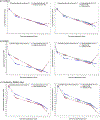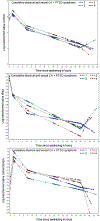The association between abuse history in childhood and salivary rhythms of cortisol and DHEA in postmenopausal women
- PMID: 31784054
- PMCID: PMC6935398
- DOI: 10.1016/j.psyneuen.2019.104515
The association between abuse history in childhood and salivary rhythms of cortisol and DHEA in postmenopausal women
Abstract
A history of child abuse (CA) is associated with morbidity and mortality in adulthood, and one proposed mechanism is dysregulation of the hypothalamic-pituitary-adrenal (HPA) axis. Therefore, we evaluated whether a history of physical and sexual CA was associated with daily rhythms of HPA hormones (cortisol and dehydroepiandrosterone (DHEA)) among postmenopausal women (mean age: 60.6 years). In 2013, 233 participants from the Nurses' Health Study II provided up to 5-timed saliva samples over the course of a day: immediately upon awakening, 45 min, 4 h, and 10 h after waking, and prior to going to sleep. Among these 233 participants, 217 provided ≥4 timed saliva samples. Assessment of physical and sexual CA history occurred in 2001 using the Revised Conflict Tactics Scale. Cumulative CA history was derived by combining reports of physical and sexual abuse prior to age 18. Piecewise linear mixed models compared diurnal rhythms of cortisol and DHEA between participants with none-to-moderate CA (n = 104, reference group) versus high-to-severe CA (n = 113). Models adjusted for characteristics at each saliva collection, health status, sleep quality, medications, and hormone use. Compared to those with none-to-moderate CA, women with high-to-severe CA had different diurnal rhythms in the early and evening hours, including blunted (less steep) early declines in DHEA (% difference (%D) = 10.7, 95 % Confidence Interval (CI) 4.3, 17.5), and steeper late declines in both cortisol and DHEA (cortisol %D = -2.5, 95 % CI -4.8, -0.1, and DHEA %D= -3.9, 95 % CI -6.0, -1.8). In conclusion, high-to-severe abuse history prior to age 18 was more strongly associated with differences in DHEA rather than cortisol, suggesting that early life abuse may be related to dysregulation of stress-response mechanisms later in life.
Keywords: Child abuse; Cortisol; Cortisol to DHEA ratio; DHEA; Postmenopausal.
Copyright © 2019 Elsevier Ltd. All rights reserved.
Conflict of interest statement
CONFLICTS OF INTEREST
None.
Figures


Similar articles
-
Religion, spirituality and diurnal rhythms of salivary cortisol and dehydroepiandrosterone in postmenopausal women.Compr Psychoneuroendocrinol. 2021 Aug;7:100064. doi: 10.1016/j.cpnec.2021.100064. Epub 2021 Jun 6. Compr Psychoneuroendocrinol. 2021. PMID: 34308392 Free PMC article.
-
Habitual sleep quality and diurnal rhythms of salivary cortisol and dehydroepiandrosterone in postmenopausal women.Psychoneuroendocrinology. 2017 Oct;84:172-180. doi: 10.1016/j.psyneuen.2017.07.484. Epub 2017 Jul 19. Psychoneuroendocrinology. 2017. PMID: 28738312 Free PMC article.
-
Associations of waking cortisol with DHEA and testosterone across the pubertal transition: Effects of threat-related early life stress.Psychoneuroendocrinology. 2020 May;115:104651. doi: 10.1016/j.psyneuen.2020.104651. Epub 2020 Mar 12. Psychoneuroendocrinology. 2020. PMID: 32199287 Free PMC article.
-
HPA axis regulation in posttraumatic stress disorder: A meta-analysis focusing on potential moderators.Neurosci Biobehav Rev. 2019 May;100:35-57. doi: 10.1016/j.neubiorev.2019.02.005. Epub 2019 Feb 19. Neurosci Biobehav Rev. 2019. PMID: 30790632 Review.
-
Physical Activity Influences Cortisol and Dehydroepiandrosterone (Sulfate) Levels in Older Adults: A Systematic Review and Meta-Analysis.J Aging Phys Act. 2022 Aug 17;31(2):330-351. doi: 10.1123/japa.2021-0501. Print 2023 Apr 1. J Aging Phys Act. 2022. PMID: 35981715
Cited by
-
Childhood adversity and time to pregnancy in a preconception cohort.Am J Epidemiol. 2024 Nov 4;193(11):1553-1563. doi: 10.1093/aje/kwae085. Am J Epidemiol. 2024. PMID: 38794905 Free PMC article.
-
The role of neurosteroids in posttraumatic stress disorder and alcohol use disorder: A review of 10 years of clinical literature and treatment implications.Front Neuroendocrinol. 2024 Apr;73:101119. doi: 10.1016/j.yfrne.2023.101119. Epub 2024 Jan 4. Front Neuroendocrinol. 2024. PMID: 38184208 Free PMC article. Review.
-
Childhood and adolescent nutrition outcomes among girls exposed to gender-based violence: A rapid evidence assessment of quantitative research.PLoS One. 2023 Feb 16;18(2):e0281961. doi: 10.1371/journal.pone.0281961. eCollection 2023. PLoS One. 2023. PMID: 36795761 Free PMC article.
-
Association of early life physical and sexual abuse with premature mortality among female nurses: prospective cohort study.BMJ. 2023 May 3;381:e073613. doi: 10.1136/bmj-2022-073613. BMJ. 2023. PMID: 37137504 Free PMC article.
-
Religion, spirituality and diurnal rhythms of salivary cortisol and dehydroepiandrosterone in postmenopausal women.Compr Psychoneuroendocrinol. 2021 Aug;7:100064. doi: 10.1016/j.cpnec.2021.100064. Epub 2021 Jun 6. Compr Psychoneuroendocrinol. 2021. PMID: 34308392 Free PMC article.
References
-
- Felitti VJ, Anda RF, Nordenberg D, Williamson DF, Spitz AM, Edwards V, et al. Relationship of childhood abuse and household dysfunction to many of the leading causes of death in adults. The Adverse Childhood Experiences (ACE) Study. Am J Prev Med. 1998;14(4):245–58. - PubMed
-
- Gilbert LK, Breiding MJ, Merrick MT, Thompson WW, Ford DC, Dhingra SS, et al. Childhood adversity and adult chronic disease: an update from ten states and the District of Columbia, 2010. Am J Prev Med. 2015;48(3):345–9. - PubMed
Publication types
MeSH terms
Substances
Grants and funding
LinkOut - more resources
Full Text Sources
Other Literature Sources

